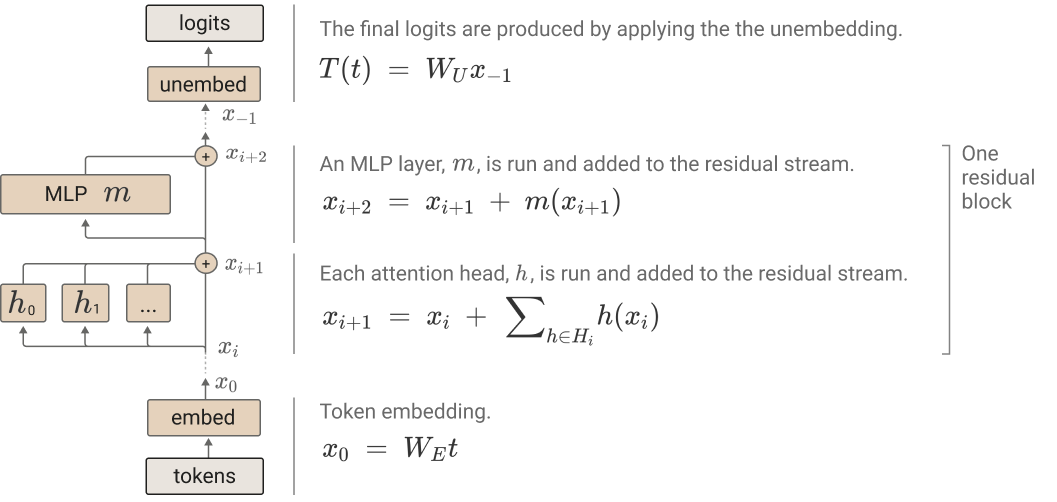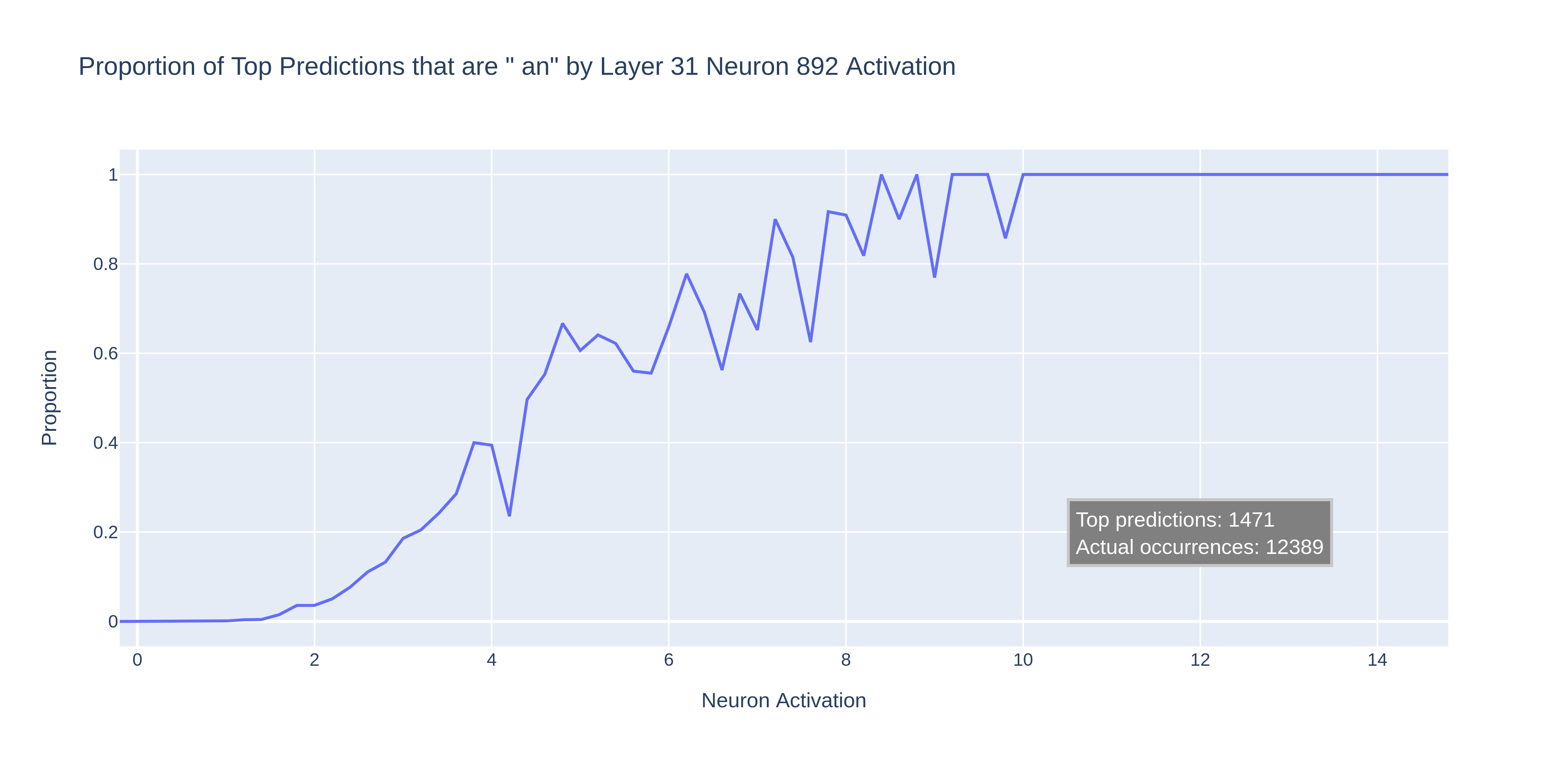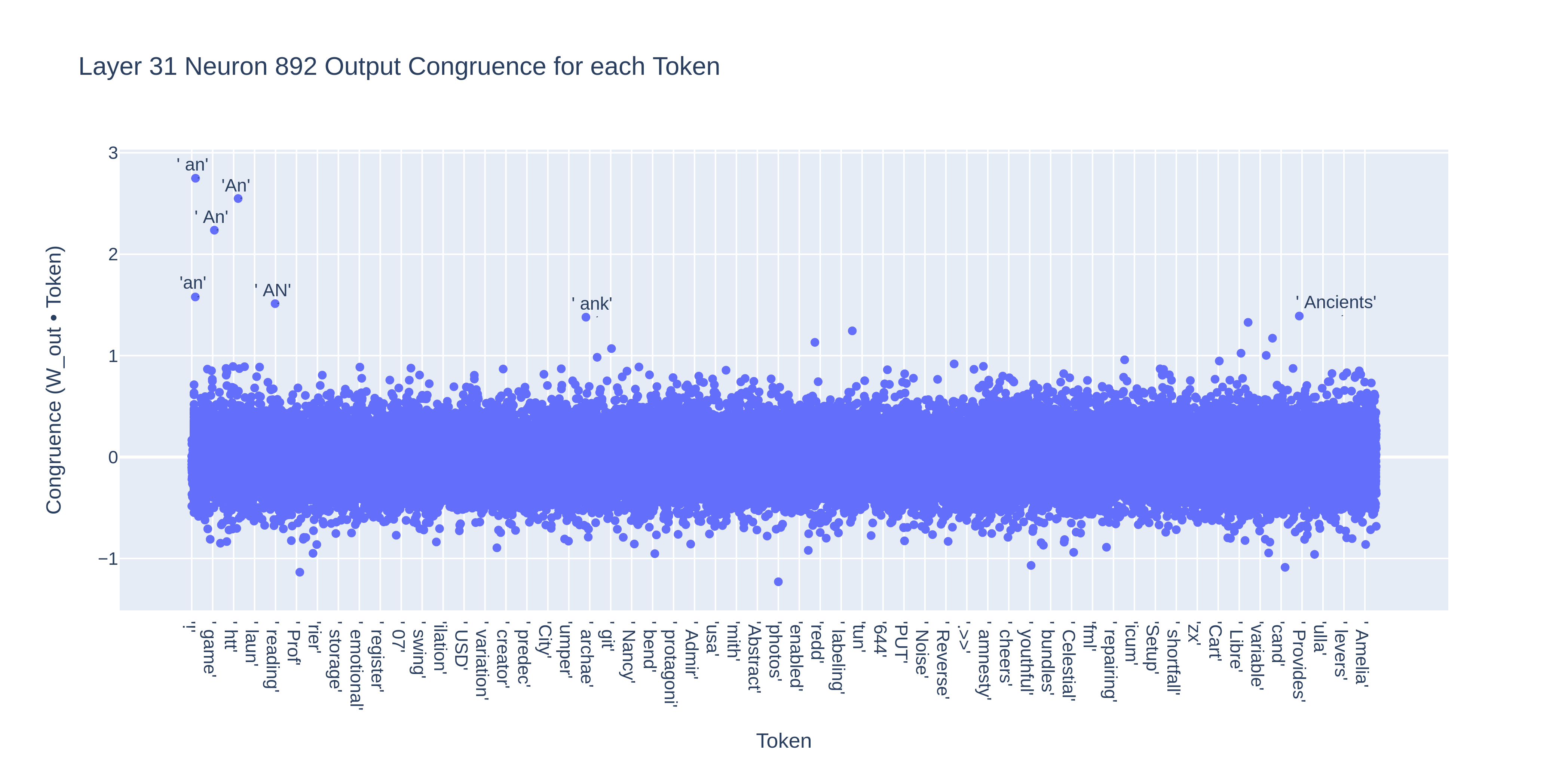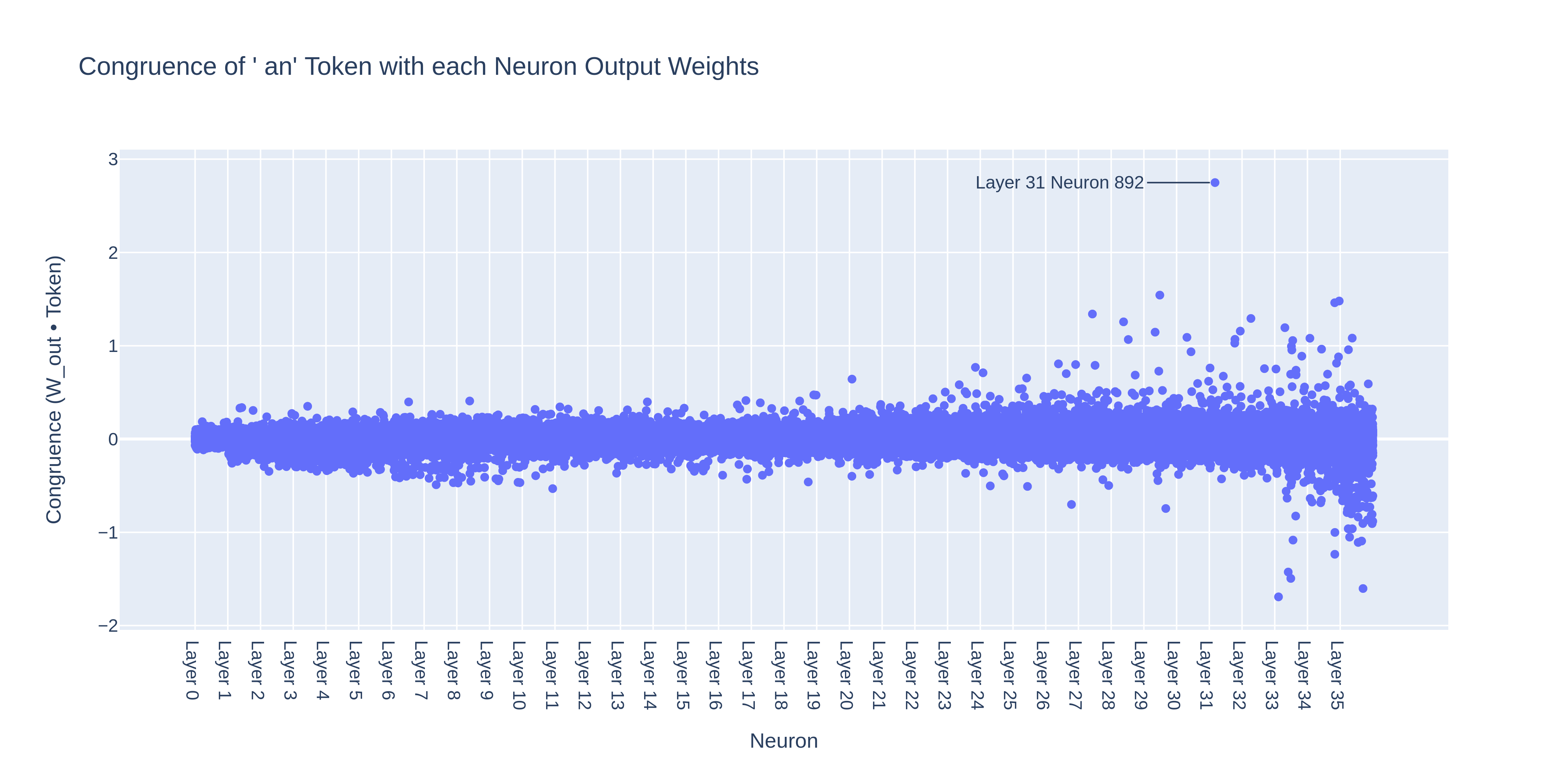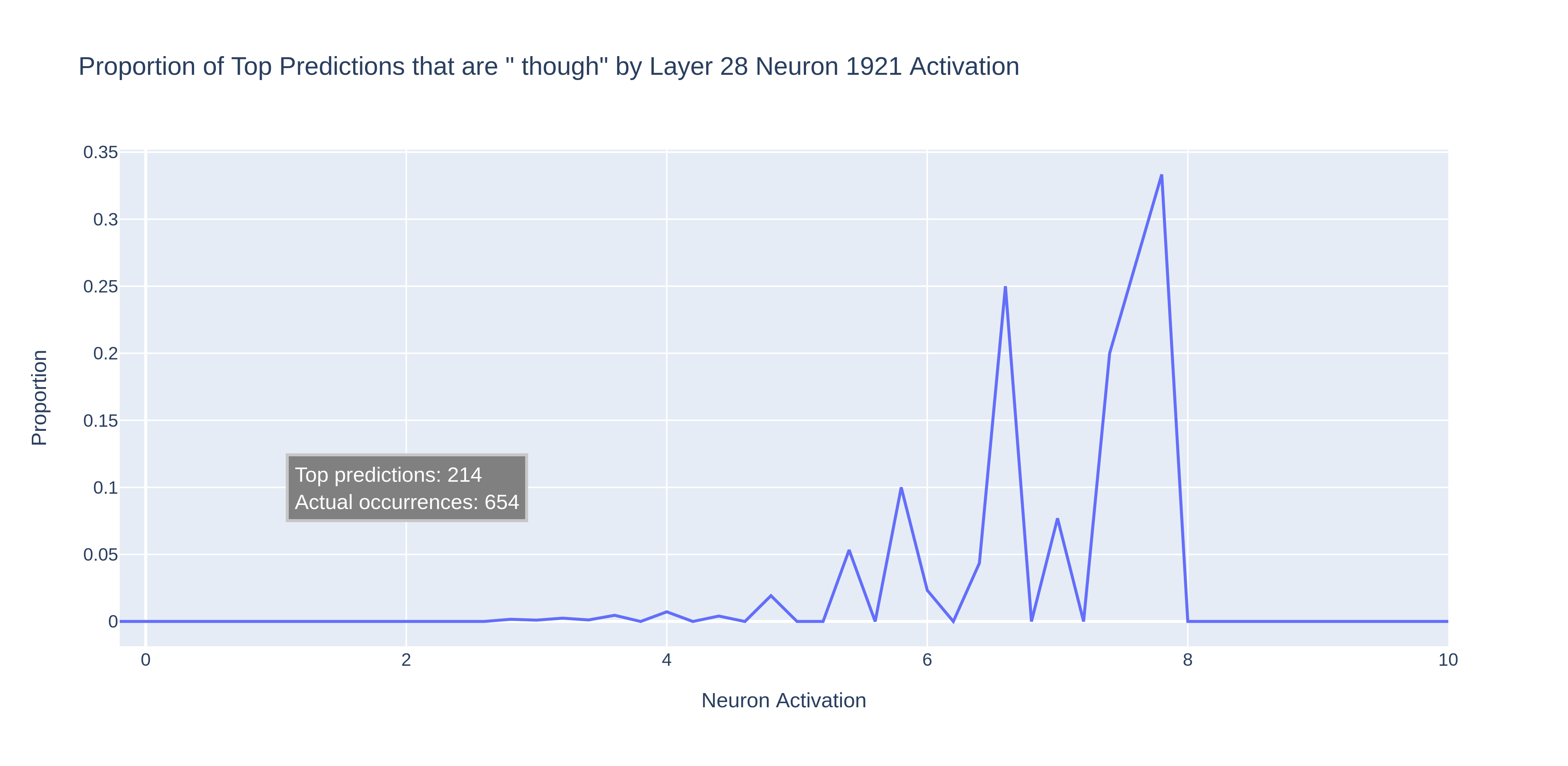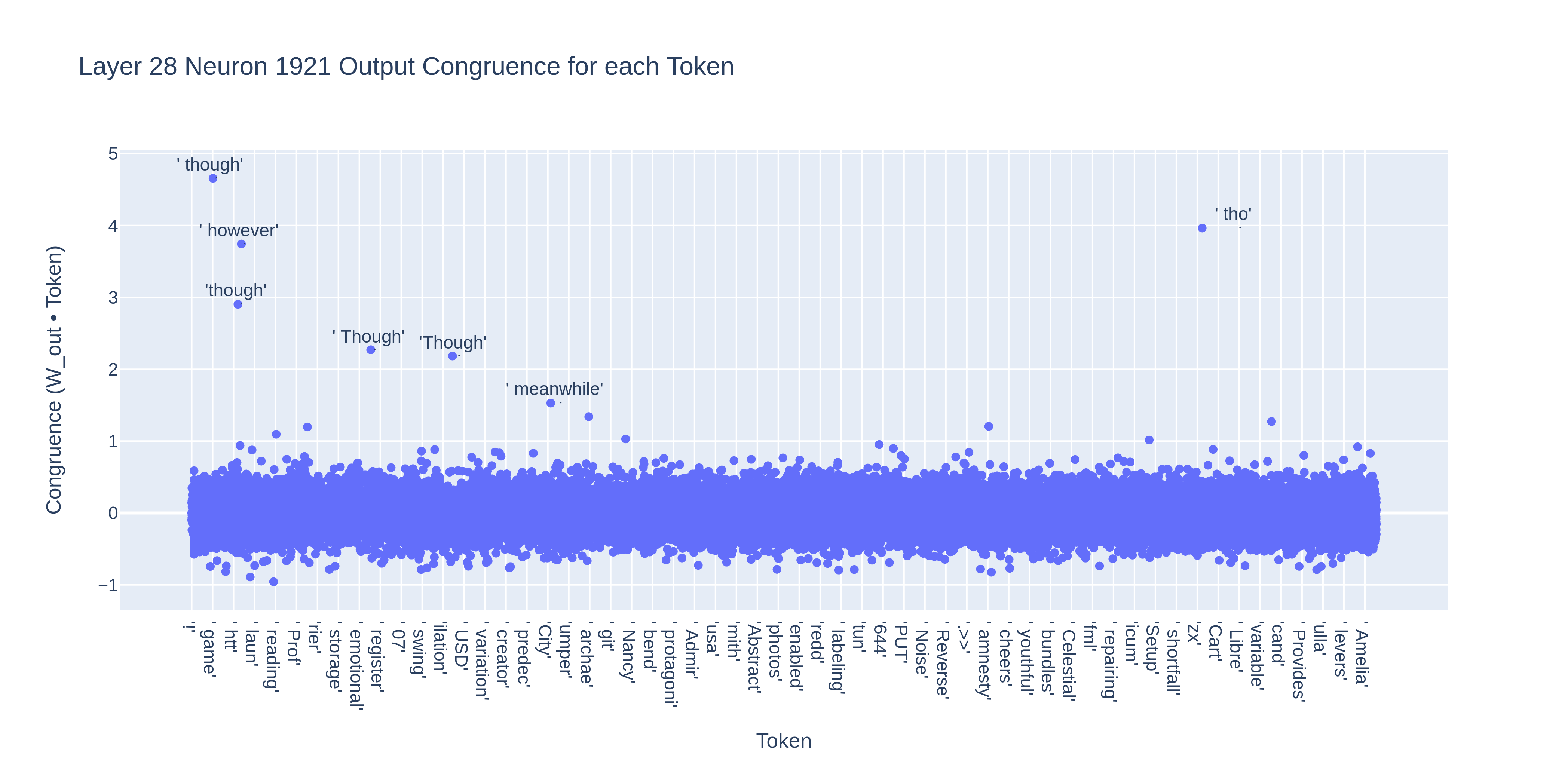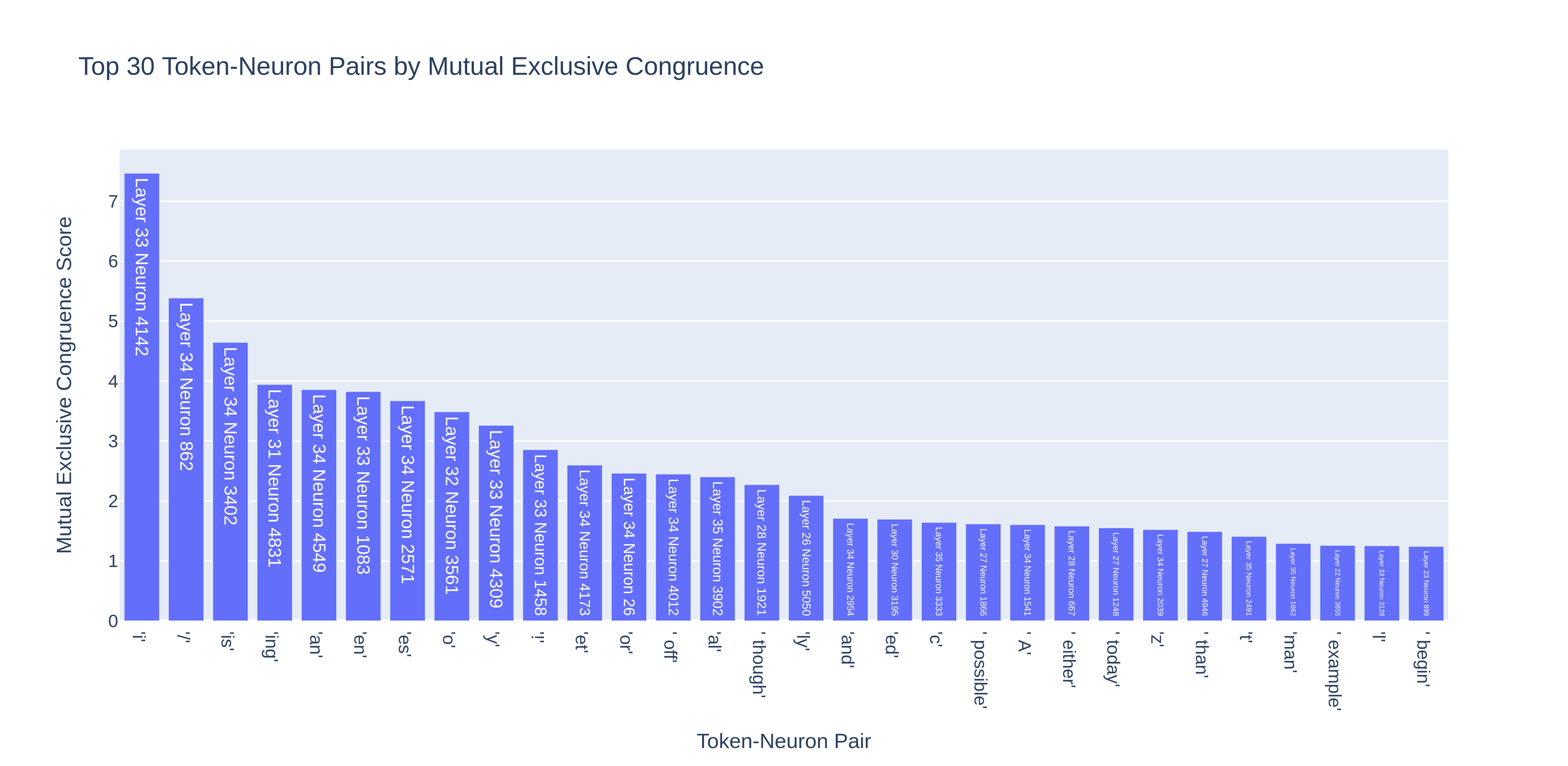143
143
Ω 53
We Found An Neuron in GPT-2
6JenniferRM
6LawrenceC
4Joseph Miller
3LawrenceC
6Clement Neo
1Aryan Bhatt
5Tom Lieberum
3Logan Riggs
1Tom Lieberum
4LawrenceC
3LawrenceC
1[anonymous]
2Joseph Miller
5the gears to ascension
2Logan Riggs
2Joseph Miller
1Review Bot
1aaronsnoswell
1Joseph Miller
1scasper
2Clement Neo
1scasper
2Joseph Miller
New Comment
I notice that the token in question happens to be segmented as "_an" and "_a" and not "_an_" or "_a_".
So continuations like ["_a","moral","_fruit"] or ["_an","tagonist","ic","_monster","s"] could be possible (assuming those are all legal tokens).
I am reminded of the wonderful little nuggest in linguistics, where people are supposed to have said something like "a narange" (because that kind of fruit came from the spanish province of "naranja"). The details on these claims are often not well documented.
Relatively more scholarly analysis of such "junctural resegmentation" issues does exist though!
Something that might be tried is to look for neurons that are very likely to be active two or three steps before a given token is actually produced, which might represent a sort of "intent for the token to show up eventually".
If you find such things, I might suggest that they be named "Wernicke Neurons", and I wouldn't be surprised if they ended up being highly/visibly related to "an intelligible semantic intent" in sketches of active speaking personas who probably want to eventually/potentially touch on >1 keywords.
The thing I would expect is that many related keywords would have prioritization before they are uttered, and they would hold each other somewhat in abeyance, with jostling and deal making amongst themselves, maybe with some equivalent to Broca's Area as the judge of who should win when various Wernicke Neurons try to make their ideas "go out the door" first (or at all)?
Cool results!
A few questions:
- The total logit diff between "a" and "an" contributed by layer 31 seems to be ~1.5 based on your logit lens figure, but your neuron only contributes ~0.4 -- do you have a sense of how exactly the remaining 1.1 is divided?
- What's going on with the negative logit lens layers?
- Is there a reason you focus on output congruence as opposed to cosine similarity (which is just normalized congruence)? Intuitively, it seems like the scale of the output vector of an MLP neuron can relatively arbitrary (only constrained to some extent by weight decay), since you can always scale the input instead. Do you expect the results to be different if you used that metric instead?
(I'm guessing not because of the activation patching experiment)
The total logit diff between "a" and "an" contributed by layer 31 seems to be ~1.5 based on your logit lens figure, but your neuron only contributes ~0.4 -- do you have a sense of how exactly the remaining 1.1 is divided?
Sorry we didn't explain what the scales are on the figures! I've added a clarification in the post. The first graph is the absolute logit difference between " a" and " an". For each of the activation patching figures, the metric shown is the relative logit recovery:
So means the patch recovered the same logit diff as the clean prompt, means patch didn't change the corrupted prompt's logit diff, means the patch made the logit diff worse than the corrupted prompt etc.
We can see from the MLP layer patching figure that patching MLP 31 recovers 49% of the performance of the clean prompts (you can see the exact numbers on the interactive figures in the linkpost). And from the neuron patching figure we see that patching just Neuron 892 recovers 50% of the clean prompt performance, so actually the rest of the layer is entirely unhelpful.
The next question might be: "Why does patching MLP 31 only recover 49% of the performance when the logit lens makes it look like it's doing all the work?" I'm not sure what the answer to this is but I also don't think it's particularly surprising. It may be that when running the corrupted activation, MLP 33 adds a bunch of the " a" logit to the residual, which patching MLP 31 doesn't change very much.
What's going on with the negative logit lens layers?
I think this just means that for the first 30 layers the model moves towards " a" being a better guess than " an". I expect a lot of the computation in these layers is working out that an indefinite article is required, of which " a" is more likely a priori. Only at layer 31 does it realize that " an" is actually more appropriate in this situation than " a".
Is there a reason you focus on output congruence as opposed to cosine similarity (which is just normalized congruence)? Intuitively, it seems like the scale of the output vector of an MLP neuron can relatively arbitrary (only constrained to some extent by weight decay), since you can always scale the input instead. Do you expect the results to be different if you used that metric instead?
It seems to me like using cosine similarity could give different and misleading results. Imagine if " an" pointed in the exact same direction (cosine similarity ) as two neurons. If one of the two neurons has magnitude bigger than the other, then it will have more impact on the " an" logit.
I don't understand what you mean by "you can always scale the input instead". And as input to the MLP is the LayerNorm of the residual up that point the magnitude of the input is always the same.
Thanks for clarifying the scales!
I don't understand what you mean by "you can always scale the input instead". And as input to the MLP is the LayerNorm of the residual up that point the magnitude of the input is always the same.
I might be misremembering the GPT2 architecture, but I thought the output of the MLP layer was something like ? So you can just scale up when you scale down. (Assuming I'm remembering the architecture correctly,) if you're concerned about the scale of the output, then I think it makes sense to look at the scale of as well.
We took dot product over cosine similarity because the dot product is the neuron’s effect on the logits (since we use the dot product of the residual stream and embedding matrix when unembedding).
I think your point on using the scale if we are concerned about the scale of is fair — we didn’t really look at how the rest of the network interacted with this neuron through its input weights, but perhaps a input-scaled congruence score (e.g. output congruence * average of squared input weights) could give us a better representation of a neuron’s relevance for a token.
I do agree that looking at alone seems a bit misguided (unless we're normalizing by looking at cosine similarity instead of dot product). However, the extent to which this is true is a bit unclear. Here are a few considerations:
- At first blush, the thing you said is exactly right; scaling up and scale down will leave the implemented function unchanged.
- However, this'll affect the L2 regularization penalty. All else equal, we'd expect to see , since that minimizes the regularization penalty.
- However, this is all complicated by the fact that you can also alternatively scale the LayerNorm's gain parameter, which (I think) isn't regularized.
- Lastly, I believe GPT2 uses GELU, not ReLU? This is significant, since it no longer allows you to scale and without changing the implemented function.
Nice work, thanks for sharing! I really like the fact that the neurons seem to upweight different versions of the same token (_an, _An, an, An, etc.). It's curious because the semantics of these tokens can be quite different (compared to the though, tho, however neuron).
Have you looked at all into what parts of the model feed into (some of) the cleanly associated neurons? It was probably out of scope for this but just curious.
One reason the neuron is congruent with multiple of the same tokens may be because those token embeddings are similar (you can test this by checking their cosine similarities).
Yup! I think that'd be quite interesting. Is there any work on characterizing the embedding space of GPT2?
Adam Scherlis did some preliminary exploration here:
https://www.lesswrong.com/posts/BMghmAxYxeSdAteDc/an-exploration-of-gpt-2-s-embedding-weights
Here's a more thorough investigation of the overall shape of said embeddings with interactive figures:
https://bert-vs-gpt2.dbvis.de/
There's also a lot of academic work on the geometry of LM embeddings, e.g.:
- https://openreview.net/forum?id=xYGNO86OWDH (BERT, ERNIE)
- https://arxiv.org/abs/2209.02535 (GPT-2-medium)
(Plus a mountain more on earlier text/token embeddings like Word2Vec.)
https://www.lesswrong.com/posts/aPeJE8bSo6rAFoLqg/solidgoldmagikarp-plus-prompt-generation is related to the embedding space
Have you looked at all into what parts of the model feed into (some of) the cleanly associated neurons? It was probably out of scope for this but just curious.
We did look very briefly at this for the " an" neuron. We plotted the residual stream congruence with the neuron input weights throughout the model. The second figure shows the difference from each layer.
Unfortunately I can't seem to comment an image. See it here.
We can't tell that much from this but I think there are three takeaways:
- The model doesn't start 'preparing' to activate the
" an"neuron until layer 16. - No single layer stands out a lot as being particularly responsible for the
" an"neuron's activation (which is part of why we didn't investigate this further). - The congruence increases a lot after MLP 31. This means the output of layer 31 is very congruent with the input weights of the
" an"neuron (which is in MLP 31). I this this is almost entirely the effect of the" an"neuron, partly because the input of the" an"neuron is very congruent with the" an"token (although not as much as the neuron output weights). This makes me think that this neuron is at least partly a 'signal boosting' neuron.
The first time I saw this post, I didn't understand. Then I had an insight, and now I get a pun
For clarifying my own understanding:
The dot product of the row of a neuron’s weight vector (ie a row in W_out) with the unembedding matrix (in this case the embedding.T because GPT is tied embeddings) is what directly contributes to the logit outputs.
If the neuron activation is relatively very high, then this swamps the direction of your activations. So, artificially increasing W_in’s neurons to eg 100 should cause the same token to be predicted regardless of the prompt.
This means that neuron A could be more congruent than neuron B, but B contribute more to the logits of their token simply because B is activated more.
This is useful for mapping features to specific neurons if those features can be described as using a single token (like “ an”). I’d like to think more later about finding neurons for groups of speech, like a character’s catch phrase.
This seems all correct to me except possibly this:
So, artificially increasing W_in’s neurons to eg 100 should cause the same token to be predicted regardless of the prompt
W_in is the input weights for each neuron. So you could increase the activation of the " an" neuron by multiplying the input weights of that neuron by 100. (ie. .)
And if you increase the " an" neuron's activation you will increase " an"'s logit. Our data suggests that if the activation is then it will almost always be the top prediction.
If the neuron activation is relatively very high, then this swamps the direction of your activations
I think this is true but not necessarily relevant. On the one hand, this neuron's activation will increase the logit of " an" regardless of what the other activations are. On the other hand if the other activations are high then this may reduce the probability of " an" by either increasing other logits or activating other neurons in later layers that output the opposite direction to " an" to the residual stream.
The LessWrong Review runs every year to select the posts that have most stood the test of time. This post is not yet eligible for review, but will be at the end of 2024. The top fifty or so posts are featured prominently on the site throughout the year.
Hopefully, the review is better than karma at judging enduring value. If we have accurate prediction markets on the review results, maybe we can have better incentives on LessWrong today. Will this post make the top fifty?
Hello! A great write-up and fascinating investigation. Well done with such a great result from a hackathon.
I'm trying to understand your plot titled 'Proportion of Top Predictions that are " an" by Layer 31 Neuron 892 Activation'. Can you explain what the y-axis is in this plot? It's not clear what the y-axis is a proportion of.
I read through the code, but couldn't quite follow the logic for this plot. It seems that the y-axis is computed with these lines;
neuron_act_top_pred_proportions = [dict(sorted([(k / bin_granularity, v["top_pred"] / v["count"])
for k, v in logit_bins.items()])) for logit_bins in logit_diff_bins.values()]But I'm not sure what the numerator v["count"] from within logit_bins corresponds to.
Thank you :)
Aaron
Hi!
For each token prediction we record the activation of the neuron and whether on not " an" has a greater logit than any other token (if it was the top prediction).
We group the activations into buckets of width . For each bucket we plot
Does that clarify things for you?
How was the ' a' v. ' an' selection task selected? It seems quite convenient to probe for and also the kind of thing that could result from p-hacking over a set of similar simple tasks.
The prompt was in a style similar to the [Interpretability In The Wild](https://arxiv.org/abs/2211.00593) paper, where one token (' an') would be the top answer for the pre-patched prompt — the one with 'apple', and the other token (' a') would be the the top answer for the patched prompt — the one with 'lemon'. The idea is that with these prompts is that we know that the top prediction is either ' an' or ' a', and we can measure the effect of each individual part of the model by seeing how much patching that part of the model sways the prediction towards the ' a' token.
To be clear, this can only tell us the significance of this neuron in this particular prompt, which is why we also tried to look at the behaviour of this neuron through other perspectives — which was looking at its activation over a larger, diverse dataset, and looking at its output weights.
Thanks, but I'm asking more about why you chose to study this particular thing instead of something else entirely. For example, why not study "this" versus "that" completions or any number of other simple things in the language model?
I don't think there was much reason for choosing " a" vs. " an" to study over something else. This was the first thing we investigated and we were excited to see a single neuron mechanism, so we kept going. Bear in mind this project originated in a 48 hour hackathon :)
Curated and popular this week
